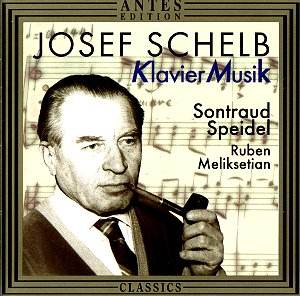Schelb led a long and busy life, as a pianist,
teacher of piano and composition, and composer. As a composer,
he was naturally drawn to his own instrument for which he composed
a substantial body of works including, besides the ones recorded
here, four piano sonatas, Klaviermusik Nr.1 (1929),
Zehn kleine Klavierstücke (1949) as well as
several pieces for two pianos.
The four works in this selection span some twenty
years of his composing career, thus providing for a fine and fairly
comprehensive survey of his musical progress. Klaviermsuik
Nr.2, written during World War II when Schelb was playing
for German troops in France and Belgium, is still overtly Neo-classical,
rather closely indebted to Hindemith, energetic and motoric in
the fast movements, lyrical in the beautiful third movement.
The Partita ritmica for two pianos
of 1951 is still much in the same vein, albeit with much greater
freedom and more refined character, as well as with a more flexible
rhythmic vitality redolent of Bartok. Again in four movements,
with a substantial Canzona canonica framed by a lively
Burletta and the energetic final Tarantella, the
whole work opening with a rather impressive Entrata.
The 15 kleine Stücke of 1954,
as the somewhat earlier 10 kleine Klavierstücke
of 1949 (available on ANTES LC 7985), are avowedly didactic pieces,
though of great charm, likely to challenge and reward young players’
efforts. As may be expected, this is a set of short clearly contrasted
miniatures, in turn rhythmically alert, lyrical and more sternly
contrapuntal, all expertly done, probably not quite easy to play
but well worth the effort (I mean, on the player’s part).
The somewhat later Vier Klavierstücke
of 1962 are, needless to say, much more serious in intent and
technically quite demanding. The idiom, though clearly from the
same pen as the other pieces, is more varied and expands into
twelve-note writing, although Schelb’s use of dodecaphony is far
from dogmatic. On the whole, the music is much more chromatic
and rhythmically quite intricate. This is clearly a minor masterpiece.
Schelb’s music was new to me and I am delighted
to have been able to review this very fine release. After hearing
it, especially in such superb, idiomatic performances, one can
not but wonder why on earth music of such quality has been gathering
dust on publishers’ shelves for so many years. Time may now be
ripe for a proper re-assessment of such finely crafted music that
clearly deserves respect. Well worth looking for.
Hubert Culot
